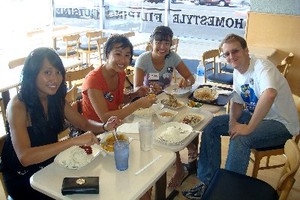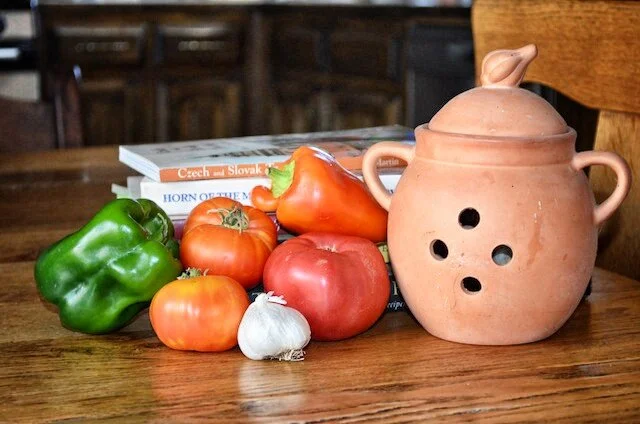When I think of Filipino restaurants, I think of Sunday brunch after mass, the drive to the other side of Union City after what felt like a long hour on a church pew, and the joy I felt when my parents let my sister and I choose our favorite dishes from the steam table at our neighborhood Filipino restaurant.
I remember the fluorescent lights and tacky mirrored walls, the one-room family restaurant next to a liquor store and a crowded Asian supermarket with the special of the day hand-written on a piece of paper and taped to the wall. Behind the counter there was usually a woman speaking Tagalog who asked what I'd like to order. She got wide-eyed and incredulous after I explained to her in English that my parents spoke English at home and I only heard Tagalog when they fought. I felt a fleeting sense of shame before she handed me my turon (fried banana roll) wrapped in tin foil or kutsinta (brown rice cake) with a little tub of shredded coconut before I sat down on a vinyl covered chair and white veneer or Formica table.
Recently, I heard from my friends about a month-old restaurant on the Peninsula named Intramuros that was "very big" and "really nice." So, of course I hot-footed it over there and found that it was not the Filipino eatery I was used to frequenting. Intramuros was really something different. The lobby of Intramuros opens to the main dining room where a grand piano sits beneath a shimmering chandelier. (Photo by John Montgomery)When I walked into the Intramuros lobby with the smiling hostess behind a sleek stone counter and a large spray of fresh flowers in a tall glass vase, I wondered why despite being the second largest Asian American subgroup in the United States with one of the a longest histories of Asian Americans in California, I had never seen a Filipino culinary establishment like this before. I’ve been to many Japanese, Chinese, Thai, Vietnamese, and Indian restaurants with varying levels of ambiance, but I was hard-pressed to find a Filipino restaurant where I could get both a sexy cocktail and a traditional Filipino plate that wasn’t necessarily fused with other Asian or European flavors. I wonder why Filipino food isn’t as ubiquitous as other Asian restaurants. But that’s a bigger question than I can answer here. For now, I was just happy to find a place that had fried banana rolls over jackfruit ice cream that was served on fine dinnerware instead of a Styrofoam carton and under chandeliers that hung from high ceilings with beveled wood.
The lobby of Intramuros opens to the main dining room where a grand piano sits beneath a shimmering chandelier. (Photo by John Montgomery)When I walked into the Intramuros lobby with the smiling hostess behind a sleek stone counter and a large spray of fresh flowers in a tall glass vase, I wondered why despite being the second largest Asian American subgroup in the United States with one of the a longest histories of Asian Americans in California, I had never seen a Filipino culinary establishment like this before. I’ve been to many Japanese, Chinese, Thai, Vietnamese, and Indian restaurants with varying levels of ambiance, but I was hard-pressed to find a Filipino restaurant where I could get both a sexy cocktail and a traditional Filipino plate that wasn’t necessarily fused with other Asian or European flavors. I wonder why Filipino food isn’t as ubiquitous as other Asian restaurants. But that’s a bigger question than I can answer here. For now, I was just happy to find a place that had fried banana rolls over jackfruit ice cream that was served on fine dinnerware instead of a Styrofoam carton and under chandeliers that hung from high ceilings with beveled wood. Today, Fort Santiago is a museum where visitors see relics of the Spanish Government, The Rizal Shrine, and trace the final footsteps of Jose Rizal, the most prominent advocate of reform in the Philippines during the Spanish colonial era, before his execution on December 29, 1896.The restaurant’s namesake means “within the walls” and refers to a walled city built by Spaniards in the 16th century when they occupied Manila. The medieval fortress sits along the southern bank of the Pasig River and is the oldest district in the city of Manila. Built in 1571, Fort Santiago, one of the oldest buildings in Intramuros, stands at the northwestern tip of the old city, and looks toward the sea where its cannons were once pointed to ward off invaders. It was also built upon the ashes of a pre-Spanish settlement ruled by Rajah Sulaiman III, the last native Muslim king of what was then called Maynila, a kingdom that would later become the site of the capital of the Philippines.
Today, Fort Santiago is a museum where visitors see relics of the Spanish Government, The Rizal Shrine, and trace the final footsteps of Jose Rizal, the most prominent advocate of reform in the Philippines during the Spanish colonial era, before his execution on December 29, 1896.The restaurant’s namesake means “within the walls” and refers to a walled city built by Spaniards in the 16th century when they occupied Manila. The medieval fortress sits along the southern bank of the Pasig River and is the oldest district in the city of Manila. Built in 1571, Fort Santiago, one of the oldest buildings in Intramuros, stands at the northwestern tip of the old city, and looks toward the sea where its cannons were once pointed to ward off invaders. It was also built upon the ashes of a pre-Spanish settlement ruled by Rajah Sulaiman III, the last native Muslim king of what was then called Maynila, a kingdom that would later become the site of the capital of the Philippines.
In the main dining room of Intramuros, both families with small children and older women dining “out with the girls” could be seen sharing the family-style portions at tables surrounding a grand piano at which a live pianist plays on Saturdays. Barry Picazo, owner of Intramuros, said that “Filipinos love to eat and sing and be entertained” and Intramuros was an opportunity to merge food and entertainment. A bar off to the side in a separate room offers a tapas-style menu and live music or comedy in the evening. And the banquet room, separated if you wish, from the main dining room by large French doors, features a dance floor and stage surrounded by tables decorated with black tablecloths and elegant white place settings.
There were so many varied dishes that were, despite not being introduced to the diners as to the content of the plates, served with friendly wait staff who stood by to fill any empty space on the table with another plate of meat sizzling on a hot iron platter or a bowl of squash or fish dressed in sauce. The food kept coming and there was plenty left over. Taking home a to-go box was inescapable (and I can attest to this tradition). Filipinos always serve much more than the table can eat, Barry explained, so guests can take any left over and enjoy it in a later meal at home.
The leche flan and fried banana rolls were my favorite. In other words, dessert was the most memorable dish (it usually is in most places, for me). That’s not to say that I’ve turned away from my neighborhood Filipino food joint. Besides, my wallet can’t take me too often to restaurants with live entertainment and a grand piano in their dining room. It’s just nice to know of a place where I can get a heaping plate of not-too-greasy pancit (stir fried noodles), stay for a drink at a top shelf bar, and feel at ease if I walked in in heels. But the local steam-table storefronts serving comfort food that’s almost as good as when grandma makes it still have a home in my heart—and in my stomach.
Melissa Josue is a San Francisco-based journalist and traveler who has written for both online and print publications and believes that travel writing is much more than about exposing a destination; it's about conveying the transformative experience of displacement, and drawing other travelers to the people and places that have deepened her sense of wonder. Melissa serves as the media and communications director for KAYA, a Filipino American grassroots organization centered on political empowerment and leadership development. She and her sister, Rosie, are contributing to YourLifeIsATrip.com with a series of pieces called THROUGH BABAE EYES: JOURNEYS WITH THE JOSUE SISTERS. The word Babae means “woman” in the Filipino language.


